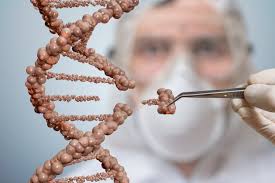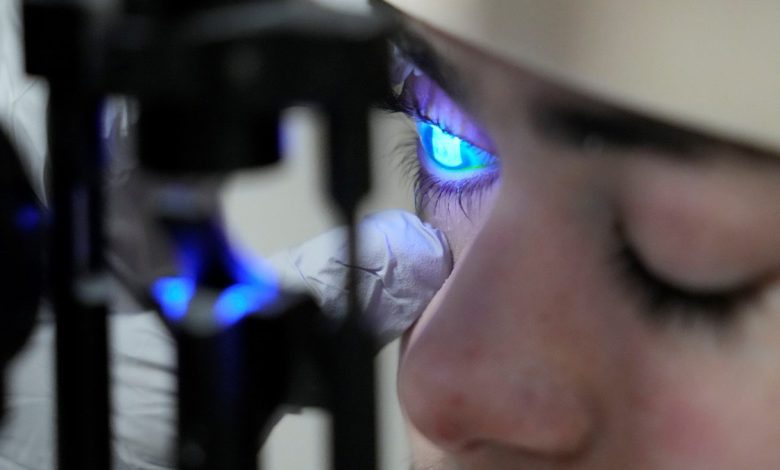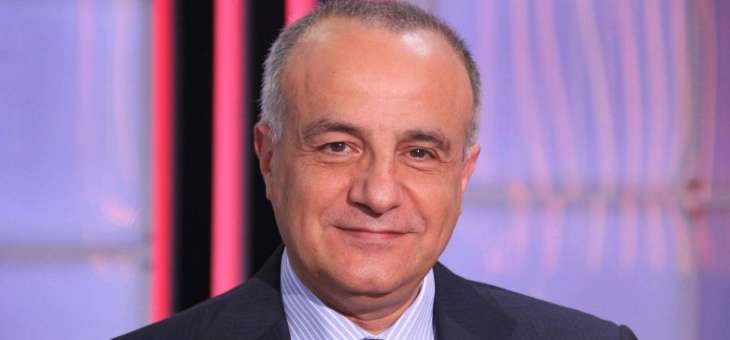اختراق جيني يعيد الأمل: علاج وراثي جديد يشفي العمى

نجح الباحثون في كلية بيرلمان للطب بجامعة بنسلفانيا في تحسين الرؤية لدى مرضى يعانون من اضطراب وراثي نادر في البصر منذ الطفولة، بفضل علاج جيني واعد.
وقد شهد هؤلاء المرضى تحسنًا سريعًا في الرؤية استمر طوال فترة الدراسة التي امتدت لمدة عام كامل.
تحسن بمقدار 100 ضعف أو أكثر؟
بعد تلقيهم العلاج الجيني الذي استهدف الطفرة الوراثية المسببة للضعف البصري، أصبحت الرؤية لدى المرضى أفضل بمقدار 100 ضعف. وفي بعض الحالات، شهد المرضى تحسنًا وصل إلى 10,000 مرة بعد تلقيهم الجرعة الأعلى من العلاج، وفقًا للباحثين في جامعة بنسلفانيا الذين قادوا التجربة السريرية، والتي نُشرت نتائجها في مجلة ذا لانسيت.
“هذا التحسن الهائل بمقدار 10,000 مرة يعادل قدرة المريض على رؤية محيطه في ليلة مقمرة في الهواء الطلق، بدلًا من حاجته إلى إضاءة داخلية قوية قبل العلاج”، كما صرح الدكتور آرتور سيديتشيان، المؤلف الرئيسي للدراسة وأستاذ طب العيون والمدير المشارك في مركز أمراض الشبكية الوراثية.
وقد أفاد أحد المرضى بقدرته على التنقل لأول مرة في منتصف الليل باستخدام ضوء نار المخيم، وفقًا لموقع Science Daily.
شارك في التجربة 15 مريضاً، بينهم 3 أطفال يعانون من ضمور الشبكية الوراثي، وهو اضطراب يؤدي إلى تدهور حاد في الرؤية يبدأ منذ الطفولة المبكرة. وينجم هذا الاضطراب عن طفرات في جين GUCY2D، الذي يعد أساسيًا لإنتاج البروتينات الحيوية للرؤية.
هذا الاضطراب الجيني يؤثر على 100,000 شخص حول العالم على الأقل، ويشتهر باسم LCA1، وهو مسؤول عن فقدان حاد للبصر في الطفولة المبكرة.
تفاصيل الدراسة
عانى جميع المشاركين في التجربة من ضعف بصري شديد، إذ لم تتجاوز قدرتهم على الرؤية مستوى 20/80 أو أسوأ، مما يعني أن المريض يجب أن يكون على مسافة 20 قدمًا لرؤية ما يمكن لشخص طبيعي رؤيته بوضوح من 80 قدمًا.
النظارات وحدها لا تكفي
النظارات تقدم فائدة محدودة لهؤلاء المرضى، حيث تصحح العيوب البصرية فقط لكنها لا تستطيع معالجة الأسباب الجذرية لفقدان البصر الناتجة عن الأمراض الوراثية في الشبكية مثل LCA1.
أثناء الدراسة، تم اختبار 3 جرعات مختلفة من العلاج الجيني ATSN-101، والتي تم حقنها جراحيًا تحت الشبكية. تلقت مجموعات من 3 بالغين جرعات منخفضة ومتوسطة وعالية، وتم تقييم سلامة العلاج قبل الانتقال إلى الجرعة التالية.
في المرحلة الثانية من الدراسة، تم إعطاء الجرعة العالية لكل من البالغين والأطفال بعد مراجعة سلامة الجرعات السابقة.
تحسن بمقدار 10,000 مرة
أظهرت النتائج، التي تضمنت القدرة على التنقل في مستويات إضاءة مختلفة، أن 3 من بين 6 مرضى تلقوا الجرعة الأعلى حققوا أفضل النتائج الممكنة. كما أظهر اثنان من المرضى الذين تلقوا الجرعة العالية تحسنًا بمقدار 10,000 ضعف في الرؤية.
أوضح الدكتور سيديتشيان أنه بالرغم من التوقعات السابقة بتحسين كبير في الرؤية لحالة LCA1، “لم نكن نعلم مدى استجابة المستقبلات الضوئية في الشبكية للعلاج بعد عقود من العمى.” وأكد أن التجربة كانت مثيرة للغاية نظرًا للنتائج الهائلة التي حققتها.
الهدف الأساسي من الدراسة كان أيضًا تقييم سلامة العلاج الجيني والجرعات المختلفة، حيث تم تسجيل بعض الآثار الجانبية المتعلقة بالإجراءات الجراحية، مثل النزيف في طرف العين الخارجي الذي شُفي لاحقًا، بالإضافة إلى التهابات العين التي تمت معالجتها.
جاء هذا النجاح بعد تجربة سابقة في مجال طب العيون بجامعة بنسلفانيا، حيث تم استعادة الرؤية لدى المرضى من خلال علاج حالة مختلفة من LCA. وفي وقت سابق من عام 2024، تم استخدام تقنية تعديل الجينات CRISPR-Cas9 لتحسين الرؤية لدى العديد من المرضى المصابين بنوع آخر من LCA.
كانت هذه الدراسة الأولى التي تشمل أطفالًا في أي تجربة علمية تتعلق بتعديل الجينات.
في الختام، أكد الباحثون على أهمية تطوير العلاج الجيني واستهداف مراحل مبكرة من المرض لضمان نتائج أفضل، مع الاستمرار في مراقبة سلامة العلاج قبل تعميمه.
Genetic Breakthrough Brings Hope: New Gene Therapy Cures Blindness

Researchers at the Perelman School of Medicine at the University of Pennsylvania have successfully improved the vision of patients suffering from a rare genetic eye disorder, present since childhood. This groundbreaking achievement was made possible through a promising gene therapy.
The patients experienced rapid and sustained improvements in their vision, lasting for the entire year of the study.
Vision 100 Times Stronger, or Even More?
After receiving gene therapy aimed at addressing the genetic mutation causing their vision impairment, patients reported a 100-fold improvement in their vision. Some even saw improvements up to 10,000 times after receiving the highest dose of the therapy, according to researchers at the University of Pennsylvania who led this clinical trial, published in The Lancet.
“This 10,000-fold improvement is equivalent to a patient being able to see their surroundings on a moonlit night outdoors, rather than needing bright indoor lighting before the treatment,” stated Dr. Artur Cideciyan, the study’s lead author, professor of ophthalmology, and co-director of the Center for Inherited Retinal Degenerations.
One patient even reported being able to navigate outdoors at midnight using only the light from a campfire, according to Science Daily.
The trial included 15 patients, including 3 children with inherited retinal degeneration, a condition that leads to severe vision loss from early childhood. This degeneration is caused by mutations in the GUCY2D gene, essential for producing proteins vital for vision.
This genetic disorder affects at least 100,000 people worldwide and is commonly known as LCA1 (Leber congenital amaurosis), responsible for severe vision loss in early childhood.
Details of the Study
All participants in the study suffered from severe vision impairment, with their vision measuring 20/80 or worse, meaning they could only see from 20 feet what a person with normal vision could see clearly from 80 feet.
Glasses Alone Are Not Enough
Glasses provide limited help for these patients as they correct visual impairments but do not address the medical root causes of vision loss, such as hereditary retinal diseases like LCA1.
During the study, three different doses of the gene therapy, ATSN-101, were tested, administered through surgical injections under the retina. Groups of three adults received low, medium, and high doses, with evaluations for safety conducted before moving to the next dose.
In the second phase of the study, the high dose was given to both adults and children after confirming the safety of the earlier doses.
Improvements were noticeable as early as the first month after treatment, with effects lasting for at least 12 months.
Vision Improved by 10,000 Times
The results, which included the ability to navigate in different lighting conditions, showed that three out of six patients who received the highest dose achieved the best possible outcomes. Additionally, two out of the nine patients who received the high dose saw a 10,000-fold improvement in their vision.
Dr. Cideciyan stated that while they had anticipated a significant improvement in vision for LCA1 patients, “we didn’t know how the photoreceptors [the light-sensitive cells in the retina] would respond to the treatment after decades of blindness.” He added that it was “very exciting to see that a multi-center scientific collaboration succeeded in showing the potential effectiveness of gene therapy.”
A key aspect of the study was also to evaluate the safety of the gene therapy and the various doses. The researchers recorded some side effects related to the surgical procedure, such as minor bleeding on the outer part of the eye that healed later, as well as eye inflammation that was treated.
This work follows another successful trial in ophthalmology at the University of Pennsylvania, where patients regained their vision through treatment for a different type of LCA. Earlier in 2024, gene-editing technology known as CRISPR-Cas9 was used to improve the vision of many patients with a form of LCA linked to mutations in one of the genes.
This study also marked the first time children participated in any scientific trial involving gene modifications.
In conclusion, the researchers emphasized the importance of further developing this therapy and targeting early stages of the disease to ensure better outcomes, while continuing to monitor the safety of the treatment before broader use.
 سكوبات عالمية إقتصادية – EconomyScopes إجعل موقعنا خيارك ومصدرك الأنسب للأخبار الإقتصادية المحلية والعربية والعالمية على أنواعها بالإضافة الى نشر مجموعة لا بأس بها من فرص العمل في لبنان والشرق الأوسط والعالم
سكوبات عالمية إقتصادية – EconomyScopes إجعل موقعنا خيارك ومصدرك الأنسب للأخبار الإقتصادية المحلية والعربية والعالمية على أنواعها بالإضافة الى نشر مجموعة لا بأس بها من فرص العمل في لبنان والشرق الأوسط والعالم




